 The Dell EMC Hybrid Cloud System for Microsoft debuted in late 2015 as the first validated hybrid cloud system that implemented Microsoft Cloud Platform System (CPS) Standard. The Dell EMC Hybrid Cloud System for Microsoft combines PowerEdge hardware, Dell EMC Networking, and a software stack built with Windows Azure Pack and System Center 2012 R2. Dell EMC’s vast engineering resources focused on creating a turnkey experience for new Dell EMC hybrid cloud administrators with a unified interface and a variety of licensing schemes. This was the company’s second collaboration with Microsoft on Azure-based cloud systems. Prior to CPS Standard, the companies worked together to offer Microsoft CPS Premium, targeted at much larger deployments. The Dell EMC Cloud for Microsoft Azure Stack is on deck as the company’s next Azure-based offering, expected to be available later this year.
The Dell EMC Hybrid Cloud System for Microsoft debuted in late 2015 as the first validated hybrid cloud system that implemented Microsoft Cloud Platform System (CPS) Standard. The Dell EMC Hybrid Cloud System for Microsoft combines PowerEdge hardware, Dell EMC Networking, and a software stack built with Windows Azure Pack and System Center 2012 R2. Dell EMC’s vast engineering resources focused on creating a turnkey experience for new Dell EMC hybrid cloud administrators with a unified interface and a variety of licensing schemes. This was the company’s second collaboration with Microsoft on Azure-based cloud systems. Prior to CPS Standard, the companies worked together to offer Microsoft CPS Premium, targeted at much larger deployments. The Dell EMC Cloud for Microsoft Azure Stack is on deck as the company’s next Azure-based offering, expected to be available later this year.
The Dell EMC Hybrid Cloud System for Microsoft debuted in late 2015 as the first validated hybrid cloud system that implemented Microsoft Cloud Platform System (CPS) Standard. The Dell EMC Hybrid Cloud System for Microsoft combines PowerEdge hardware, Dell EMC Networking, and a software stack built with Windows Azure Pack and System Center 2012 R2. Dell EMC’s vast engineering resources focused on creating a turnkey experience for new Dell EMC hybrid cloud administrators with a unified interface and a variety of licensing schemes. This was the company’s second collaboration with Microsoft on Azure-based cloud systems. Prior to CPS Standard, the companies worked together to offer Microsoft CPS Premium, targeted at much larger deployments. The Dell EMC Cloud for Microsoft Azure Stack is on deck as the company’s next Azure-based offering, expected to be available later this year.
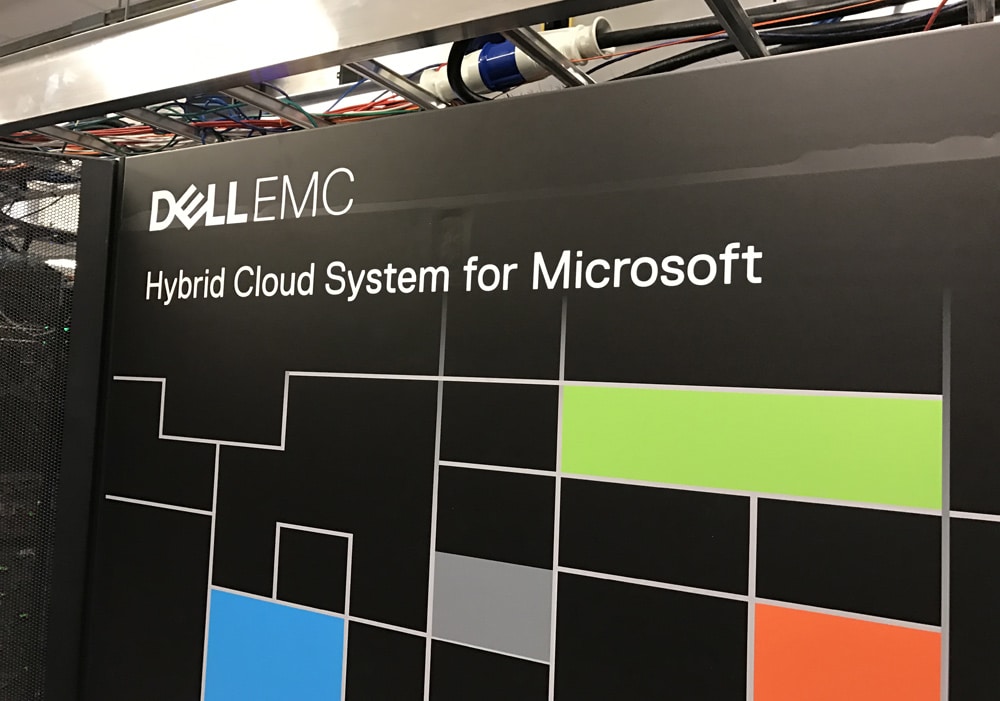
The Cloud, and people’s opinion of it, has gone through quite the evolution in the last few years. At first it was seen as a source of bulk cheap storage that wasn’t safe. As time went on, the security concerns began to fade. Organizations weren’t just using the Cloud as a source of bulk storage or a replication target, they soon began to host several of their applications in the Cloud. Now there are hundreds of organizations that are either cloud-first (the company begins and remains mainly in the cloud) or cloud-centric (the company still has on-prem gear but runs a majority of its business through the cloud). Of the three types of clouds (private, public, and hybrid), the largest growing seems to be the hybrid version. Capitalizing on this, Dell EMC continues to work with Microsoft to deliver an on-prem hybrid cloud for Microsoft shops. Additionally, Dell EMC feels they offer an incredible amount of value to customers deploying these large, and many times complex, solutions by finding bugs and sorting out patch issues well before a customer gets their hands on it. That way, when Microsoft’s Patch Tuesday comes around, Dell EMC’s Hybrid Cloud Team makes the update process painless for their end customer. Dell EMC also notes value from integrations with value-added services like backup and encryption, along with its one-call support for the complete hardware-software stack and ongoing life-cycle management.
Dell EMC provided us remote access to a Hybrid Cloud System for Microsoft that was hosted at the Dell Customer Solution Center in Austin, Texas. Dell EMC’s Hybrid Cloud System is built on PowerEdge C6320 servers with Intel Xeon E5-2600 V3 processors that host up to 400 virtual machines. PowerEdge R730 servers provide file server functionality, while Dell EMC MD1400/1420 DAS arrays are configured with between 32TB and 128TB of raw storage space. For network connectivity, Dell EMC Networking S4048 10G switches are leveraged.
The DHCS comes with some configurability for users that want more or less of certain aspects. For example, the minimum configuration is one S4048 switch for networking, one PowerEdge C6320 server for compute, and a cluster of four PowerEdge R730 servers for storage. The minimum configuration comes with no backup Data Protection Manager (DPM) servers. On the flip side, if users need the maximum of everything, the DHCS can be configured with two S4048 switches for redundancy, four PowerEdge C6320 servers (16 sleds for compute), three backup DPM servers, and six PowerEdge R730 servers (two storage hosts and four storage enclosures, all accessible to the compute nodes).
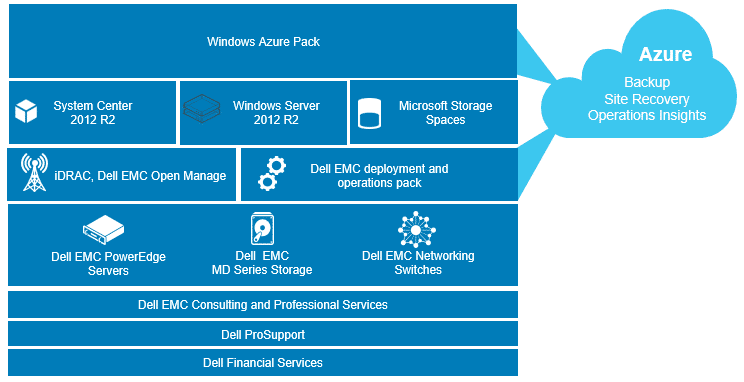
The overall value proposition of a hybrid cloud hinges on making it straightforward to granularly allocate resources to the local private cloud, as well as offsite-public and private-cloud hosts. An integrated hybrid cloud environment could succeed or fail based on whether it creates a consistent user and administrative experience across all of the resources it manages. At this point in the evolution of cloud services, it is also vital that cloud infrastructure integrates seamlessly with backup and disaster recovery services.
On the operating system and software end, Dell EMC’s implementation is based on Windows Server 2012 R2 with System Center 2012 R2 and the Windows Azure Pack. Azure is the center of the user experience, as well as the interface for most administrative tasks.
During our testing for the review we had access to Azure Backup, Azure Site Recovery, and Azure Operational Insights. Dell’s PowerEdge management system includes OpenManage Integration for System Center and Dell iDRAC 7 with LifeCycle Controller.
Dell Hybrid Cloud System for Microsoft Specifications
- Cloud platform:
- Microsoft Cloud Platform System Standard
- Microsoft Windows Server 2012 R2
- Microsoft System Center 2012 R2
- Windows Azure Pack
- Deployment and Operations:
- Dell EMC Automation and Config. Verification for Microsoft Cloud Platform System Standard
- Cloud management:
- Microsoft System Center 2012 R2
- Microsoft Azure Pack
- Systems management:
- Dell EMC iDRAC 7 Remote Access Server Management
- Dell EMC OpenManage Essentials
- Dell EMC Server Management Suite
- Dell EMC OpenManage Integration Suite for Microsoft System Center
- Compute:
- 1-4 Dell EMC PowerEdge C6320 Servers/C6300 Chassis:
- c/w 4 dual processor compute nodes per 2U shared infrastructure C6300 chassis – up to 16 compute nodes total
- Intel Xeon E5-2600 v3 family dual processors, 8/10 cores, – up to 320 cores total
- 128/256 GB memory (2133Mhz) per node
- 2 x 600GB 10K SAS HDD (boot)
- PERC H330 controller
- Network I/O
- 1GbE: Intel i350 1GbE (Mezz slot)
- 10GbE: LOM, Intel 82599ES, dual port, 10GbE
- Storage
- 2x Dell EMC PowerEdge R730 Servers with Microsoft S Storage Spaces
- Intel Xeon E5-2600 v3 family dual processors, 8/10/12 cores
- 48/64/96 GB memory (2133Mhz)
- 2 x 600GB 10K SAS HDD (boot)
- PERC H330 controller
- Network I/O: Intel X520 2x 10GbE, 2x 1GbE (PCIe)
- Controller up to: 4 x Dell 12Gbps SAS HBA
- Dell EMC MD Series MD 1400: 2×2, 2×3, 2x4configs, MD 1420:
- 2×2, 2×3, configs: 32-128TB max
- Drive Options:
- 3.5” SAS (7.2K): 2/4TB
- 2.5” SAS (10K): 1.2TB
- 2.5” SAS SSD: 400/800G
- Networking: 2x Dell EMC Networking S4048 10GbE
- 2x Dell EMC PowerEdge R730 Servers with Microsoft S Storage Spaces
- Deep Rack:
- 2x PDU, 3 phase, 208 volts, NEMA L21-30P, vertical
- 2x PDU, 3 phase, 400 volts, IEC 309 16A 3P+N+PE, IEC 309
- 20A 3P+N+E, vertical
- Standard Rack
- 4x PDU, single phase, 230 volts, IEC 309 32A 2P+E, horizontal
- 4x PDU, single phase, 220 volts, NEMA L6-30P horizontal
- Scalability
- Supports 100-400 VMs
- Compute and Storage can be scaled independently
- Microsoft Azure Cloud Services
- Azure Back-up
- Azure Site Recovery
- Azure Operational Insights
- Hypervisors
- Microsoft Hyper-V
- Scale Ready Payment Solutions
- Cloud Flex Pay – Deploy Dell EMC Hybrid Cloud System for Microsoft in a flexible, cost-effective way
- Pay As You Grow – Acquire technology now, payments increase as your business grows
- Provision and Pay – Cyclical plan, deploy, pay process
- Scale on Demand – Payments based on actual usage
Management
Our review focuses on the experience of using the Windows Azure Pack for management, although System Center 2012 R2 is also available for “traditional” Windows administration workflows. While we were working with Azure, we wanted to be sure to experience the process of deploying infrastructure as a service, database as a service, and Azure’s disaster recovery functions.
The Azure “tenant portal” is the center of the administrative experience. After selecting Azure Pack tenant, one simply needs to log in and the user will be able to easily provision a new VM.
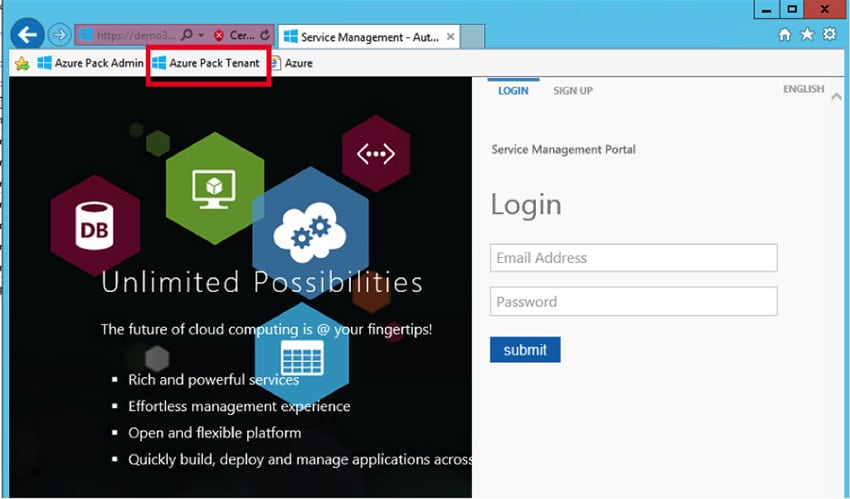
Once logged in, users see everything that has been created by the user that logged in, including VMs, gallery items, and databases. The left-hand side shows resource providers that are part of the plan. For new deployments, users need to click on the +New tab in the bottom-left corner.
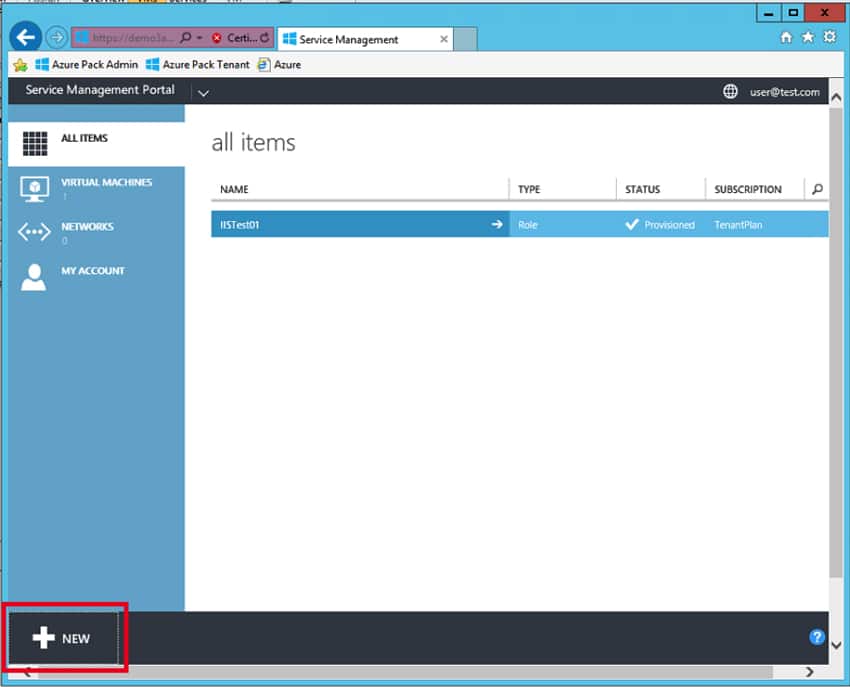
After choosing new, a pop-up screen comes up with a variety of options. Here we select “Standalone Virtual Machine” from the options listed.

After selecting Standalone Virtual Machine, we are brought to the Standalone Virtual Machine gallery. Given a variety of choices, we are going with A2_Full. To the right of the selection is info about the VM.
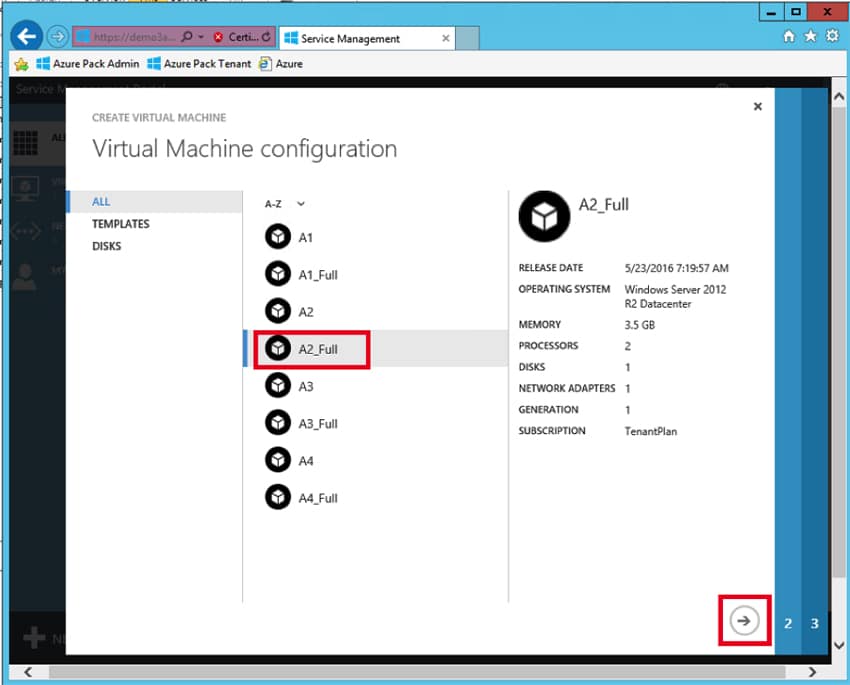
Once users select the VM they want, they will be prompted to enter a name, their username and password, as well as a product key. After that, users need to indicate where the VM will be deployed. Once this is complete, users need only to click the checkmark in the bottom right-hand corner to finish the deployment.
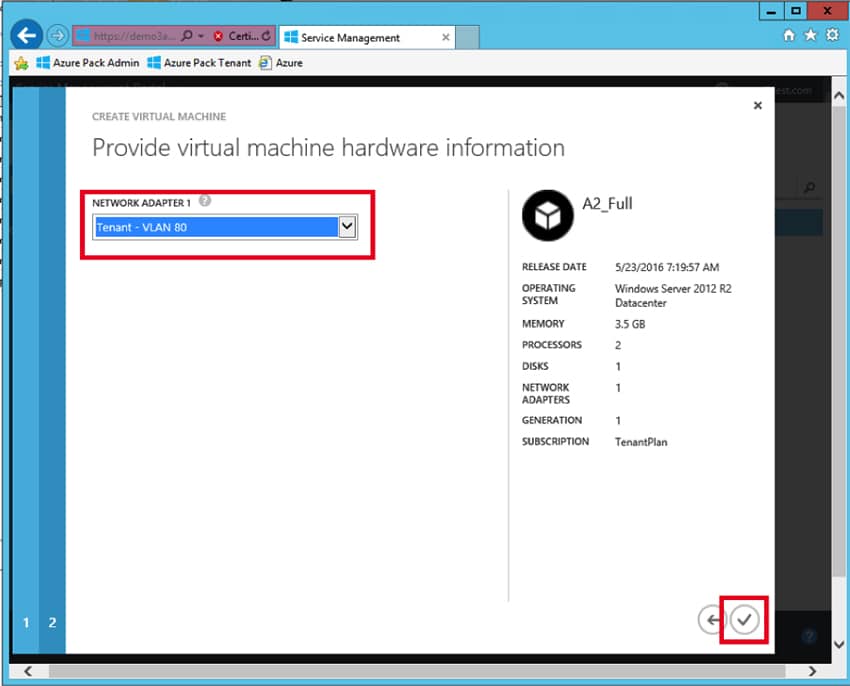
Next, we are looking at how to provision a Database as a Service (DBaaS). Going back to the Service Management portal, users simply choose MySQL Database on this go round.

Once the Database is selected, users are prompted with a window asking to name the database and the edition. This is followed by a second window asking for credentials.
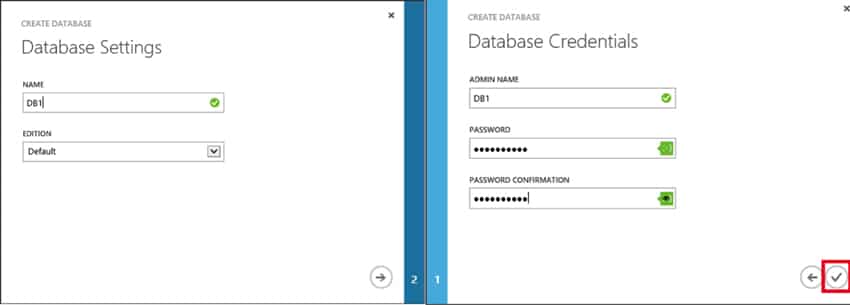
After the database is created, users again go back to the Service Management Portal. The DB1 database created a moment ago with some general information appears. For the next step, we will need the server name, which can be found under the info tab at the bottom. Once we have that, we click on +New to provision the VM role.
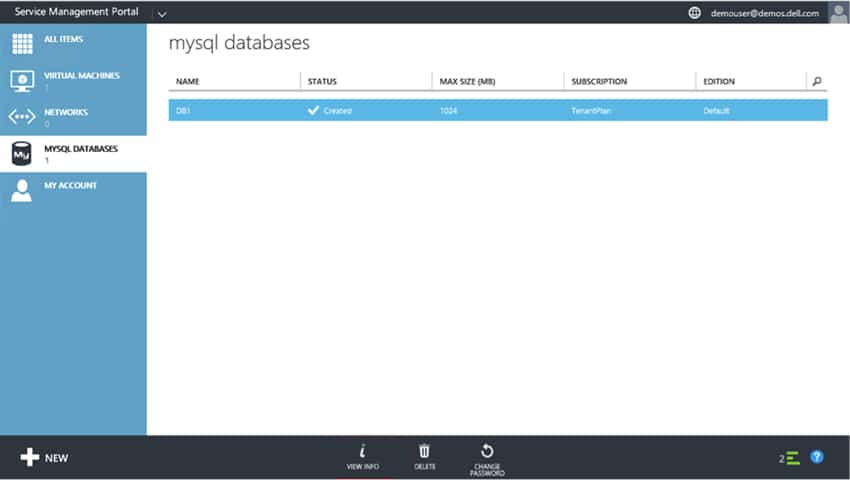
On the top of the left-hand side is the option for creating the VM Role.

Here we will be creating a WordPress instance to the database and then we will scale it out to multiple instances. Here we select WordPressExtDB and hit the arrow on the bottom right. The wizard will prompt us to name the WordPress Database (WP01 in this case) and the version. The wizard will continue to step through actions such as creating compute name pattern, time zone, root account credentials, DNS domain name, and SSH key.
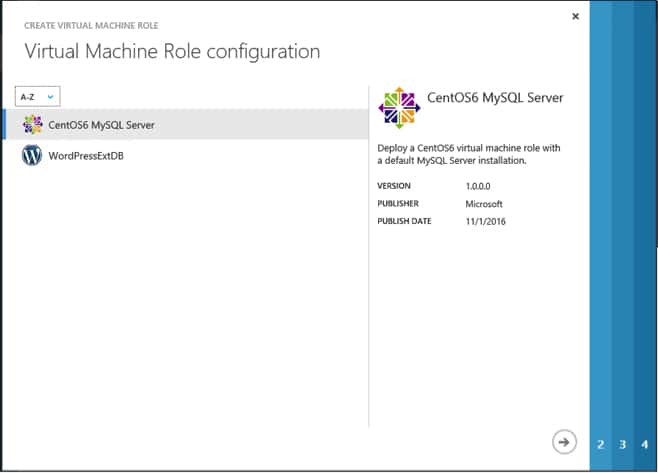
The last step uses the information from the previous steps to finish setting up the WordPress instance. Hitting the checkmark will deploy it.
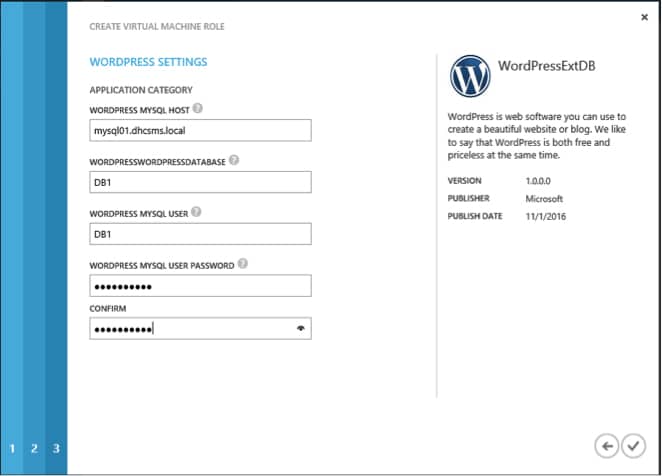
Once the WordPress instance is deployed, users can set up an account or create a web site on the web front end of WordPress. A WordPress account needs to be set up before the next step. Once the account has been set up, users can go back to the tenant portal of Azure and click on the WordPress instance to define its role.
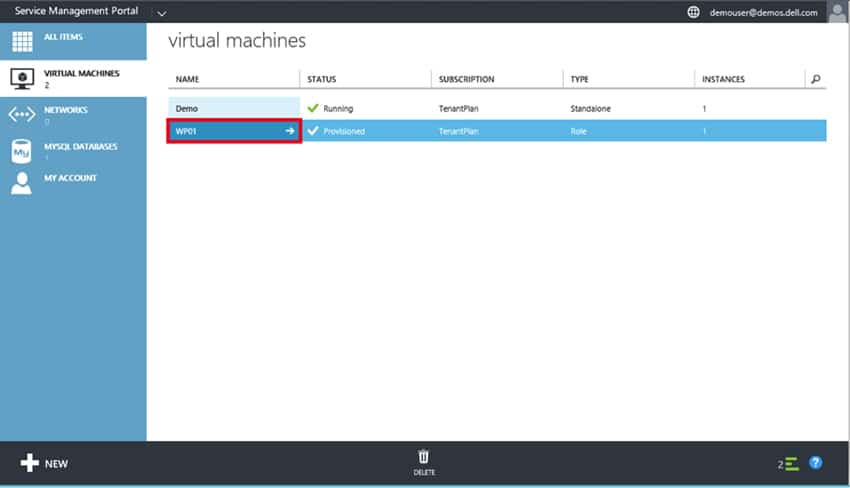
Within the role of the WordPress instance, simply select “Scale” and move the slider to the desired amount of instance needed.

Finally, we will be configuring Azure as a recovery point for disaster recovery. The DHCS comes configured to use Azure Site Recover, which means fewer steps for users. This feature is easy enough; as opposed to showing a step-by-step, it can simply be summed up in a few sentences. Users need to subscribe to a plan or add-on that has VM protection enabled. Users then create a virtual network as to how the VM will connect for failover. And then the user creates a VM for the failover.
Azure Operational Insights aggregates log data across platforms, operating systems, and coulds to provide enterprise-wide analysis.
The Dell EMC Hybrid Cloud Team feels their biggest value-add is simplifying the process for users to make updates and patches. An automated patch and update system for firmware, BIOS, drivers, and software is offered that is designed to be non-disruptive. The update framework includes intelligent dependency analysis that tests and packages patches and updates before deployment. This makes sure users spend their time managing their own needs, versus spending time making sure updates don’t break existing functionality. Moreover, Dell EMC says that it is typical to have the hybrid cloud system operational in less than three hours.
Conclusion
The Azure-centric services deployment model is a change from traditional Microsoft server administration, but one that felt intuitive and polished during our time working with the Dell EMC Hybrid Cloud System. Intuitive user experience is growing more important as the number of applications and services required for business continues to increase in most sectors.
As a cloud-native management environment, Azure has been built from the ground up with the expectation that users and administrators may need to be able to provision services and storage with granular control over whether data and compute will be hosted in the private or public cloud. Azure’s backup and disaster recovery functionality provides the means to implement a variety of common configurations in both regards, while at the same time simplifying the process to do so.
Combining years of Microsoft collaboration with the EMC heritage of turnkey hybrid cloud systems (Enterprise Hybrid Cloud and Native Hybrid Cloud), Dell EMC is now focusing its Azure-based solutions efforts on the forthcoming Dell EMC Cloud for Microsoft Azure Stack. Announced just ahead of Dell EMC World 2017 in May, this solution will combine all of Dell EMC’s past experience into a similar, yet new Microsoft-based hybrid cloud offering. Taking many of these concepts further, Dell EMC notes that its Azure Stack-based hybrid cloud system will move the experience from a disaggregated storage model (from DHCS) to a true hyper-converged model (APIs will also allow users to write once and run applications on any Azure cloud). Dell EMC says its long history with Microsoft, combined with its turnkey hybrid cloud platforms experience will give them a leg up as Azure Stack hits the market later this year. We look forward to the release of the Dell EMC Cloud for Microsoft Azure Stack and the opportunity to conduct a closer examination and review.
